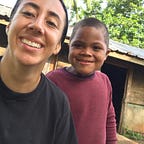Meeting Tasba Pain
When you have always had access to clean and safe water it is sometimes easy to forget how valuable it truly is. From brushing your teeth in the morning to washing your clothes, hands, and cooking meals to eat — water is at the center of all those activities. Yet in the rush of daily life it can be easy to forget how incredibly lucky it is to always have access to this basic need.
I’ve been working in the WaterAid office in Bilwi, Nicaragua for three months now and I really do love this country. If you’re ever in the area — you will be met with a warm Miskito welcome, and the most delicious food: you must try gallo pinto with fried bread fruit.
A trip to the clinic
Only one week into my trip, I had my first wakeup call about the importance of clean water. I accidentally drank some contaminated water — I’m still not sure where from — and after that, I went downhill pretty quickly.
After my second day with diarrhea (not a pretty image I know, but it was the reality) in the heat and humidity of Bilwi, I had no energy or strength to get out of bed. My co-worker took me to the clinic where the doctor put me on an IV drip. Turns out I was severely dehydrated. While at the clinic a two-year old boy was being treated next to me for exactly the same thing: he had also ingested contaminated water. I talked to his mom for a bit as we both began the process of recovery.
At the end of my visit I received a hefty bill and a list of medications I would need for a full recovery. The total cost was $71.84, a steep amount for a region where the average monthly salary is about $200.00. I couldn’t help but wonder how families like the young boy I met at hospital managed to afford this kind of treatment and I was reminded how many of these doctor visits could be avoided altogether with access to clean and safe water.
Two days later, I was finally setting off to visit Tasba Pain, a community about four hours away from Bilwi, where 603 people are soon to benefit from clean, running water! An underground pipeline will connect families directly to the water source so that they’ll have clean water right next to their homes.
The road to Tasba Pain is a bumpy, but enjoyable when you’re with the right people (Richard — the graceful driver, Max — the thoughtful community facilitator, and Bismarck, the witty program officer).
Until now, the people of Tasba Pain have collected their water from the river nearby. At any given time during the day you can catch women and girls at the river either washing clothes or collecting water for their families.
I met Jomary, a local mom with four children. She told me that her kids collect a total of six jerrycans from the river every day. They use the water to drink, cook with and for household chores and the task usually takes about an hour. That’s an hour each day, spent just collecting water.
Not only that, Jomary told me how her kids especially the younger ones Crisler, 8, Wesly, 6, and Leroy, 5 months, get sick frequently with diarrhea and vomiting. And how on average, they miss between three to four days of school when they are sick. Jomary and the other community members know that the river is contaminated. But still, they are left with no other option.
About the new project, Jomary told me:
“It will be easier with access to clean and safe water right here in our home. There will no longer be a need to collect water from the river, my kids will be able to take a bath here at home and they will no longer get sick because the water will be clean.” — Jomary
After a long day, we set up our cots at a community member’s home and set out to find dinner. Life is difficult in Tasba Pain, including the task of finding food. We managed to acquire some flour and dined on some tasty and filling tortillas. After dinner — just like the rest of Tasba Pain — we trekked down to the river to wash off the day’s sweat and hard work.
This experience will always stay with me. Here I was feeling the cool water of the river with nothing but the stars and moonlight lighting the scene. It was a remarkable experience but I soon realized that what I was marveling at as an “experience”, was daily life for the people in Tasba Pain. The trek to the river is not always safe and it is quite a way for some people.
The next day we met the small and adorable sisters Karen, 10, Cony, 7, and Liseth, 5, on their walk for water. Soon enough we met the rest of the family which includes two more sisters Clabel and Kenia, their mother, Elizabeth and father, Martin.
Martin wanted to share with everyone how life in Tasba Pain is and how he is hoping it will change for the better in the near future.
“Water is the heart of our community. Without water our people are not doing well. People live off that heart. Having water next to our homes…that is happiness and joy especially for the older people.” — Martin
It’s great to know that by the end of this year Jomary, Martin and the hundreds of other people that live in Tasba Pain will have clean and safe water right next to their home.
Follow the journey on WaterAid America’s Facebook and Instagram where I’ll be posting updates on the progress in Tasba Pain.
